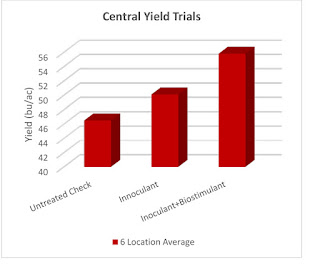With technology being so prevalent in today’s culture, data and marketing information has become a key part of life. Farmers especially have been targeted with large quantities of new technology to generate more efficient farming systems and easy real-time data access. With large amounts of data and fast access to information and product marketing being the new norm, producing a commodity requires many decisions.
While the number of US farms has dropped, average farm size has risen 23 percent from 2009 to 2016 (USDA, 2017). At the same time, producers have seen a shift in the types of ag services available. With such a wide scope of products and options available, it can be difficult to determine what products or technologies to invest in and what to leave on the shelf.
The best way to determine if a product or practice is effective is to ask for the data and research backing a company’s claims. Before a producer makes a decision, it is key to understand the data and statistics involved. However, companies sometimes leave this vital information off of advertising because many view it as confusing and unnecessary. Using unbiased data from well-designed research can make the difference in millions of dollars of decisions on ag products each year. Knowing that a product has been tested and shown to make a difference should be a deciding factor when making purchases. Yet it is not always that simple to sort through the information available.

Figure 1. Yield trial results (fictional example). The scale on the Y-axis begins at ‘40’, which can create an optical illusion for the reader and skew the appearance of data. When the axis does not begin at ‘0’, results can be misleading. In addition, no statistical analysis and little background information is provided, so the reader has no way of knowing if, for example, yields are from strips in fields or replicated trials.
| Effects of XXX on alfalfa | ||||
|---|---|---|---|---|
| Alfalfa component | Before treatment | 1st cutting | 2nd cutting | 3rd cutting |
| percent (%) | ||||
| Crude protein | 23.70 | 25.46 | 23.75 | 28.11 |
| Fat (EE) | 1.89 | 1.76 | 1.80 | 2.11 |
| Calcium | 1.25 | 1.42 | 1.53 | 1.42 |
| Sodium | 0.24 | 0.29 | 0.22 | 0.20 |
| Chloride | 1.31 | 1.36 | 1.20 | 0.60 |
| TDN | 53.96 | 63.35 | 61.51 | 61.41 |
| Actual results may vary | ||||
Figure 2. Hybrid characteristic advertisement (fictional example). This figure describes a corn hybrid with highly enticing descriptive words that may catch the reader’s attention. No data is provided and there is nothing to compare the above product claims against.
Hybrid XY Summary
Variety characteristics
Ear type: Semi-determinateCob color: Red
Strengths
High yield potential with great roots. Early flower lends to quick dry-down. Handles different types of soils and responds superbly to intensive management.Management tips
A strong performer for its maturity. Likes higher populations for the area and adequate fertility to really shine. Outstanding late season plant health leads to fast dry-down and topmost yields.Table 2. Comprehensive table (fictional example). Table includes relevant background information about the trial and statistics to help in interpretation of the information provided.
| Soybean grain yield response to XX company fertilizer product application at Somewhere, SD1 in 2014. | ||||
|---|---|---|---|---|
| Fertilizer applied | Oct. 2013 soil test2 | |||
| P | K | Zn | Yield | |
| ppm 0-6 inches | bu/ac | |||
| Product A | 13 | 150 | 11.5 | 34.1 a |
| Product B | 18 | 145 | 13.9 | 34.9 a |
| Product C | 3 | 177 | 11.0 | 20.0 c |
| Product D | 12 | 115 | 8.5 | 29.6 b |
| Pr>F | 0.01 | |||
| CV (%) | 8.7 | |||
| LSD(0.05) | 4.0 | |||
| 1Site in corn/soybean/small grain rotation since 1995. 2Nutrients applied: N=90 lb/a in 2013. Previous nutrients applied since 1997 except for 2013 were P2O5=40 lb/a/yr, K2O=50 lb/a/yr, Zn=5 lb/a/yr. | ||||
When a product is falsely promoted, the customer is often provided with only baseline information needed to make a sale. It is vital that farmers take time to look over product information, ask questions, and understand the data presented to them. Marketing claims are not always falsified or skewed, but knowing how to spot poorly-backed claims can provide farmers peace of mind in knowing they are investing in products or practices that have been properly tested.
For more information on research trials and statistics see parts one (On-farm research trial demonstrates the importance of a good design), two (Field Studies: Setting up a Trial), and three (Field Studies: What do you Mean 5 Bushels per Acre is not Significant?) of this four-part article series. If questions should arise, contact your nearest extension office for data interpretation assistance.
This article is part four in a four-part series of articles on agricultural research and interpretation by University Extension Educators in the North Central Region.

Comments
Post a Comment